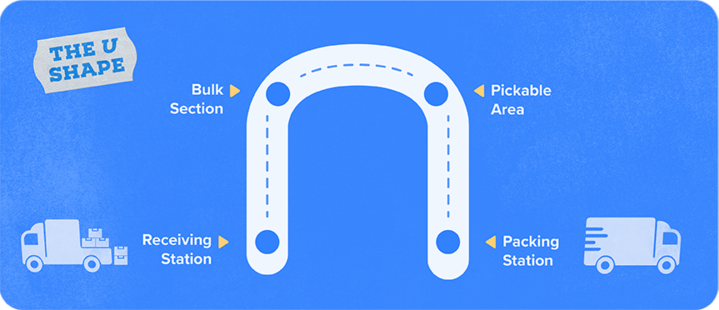The Importance of Efficient Warehouse Flow
Efficient warehouse flow is crucial for any warehouse to run smoothly. A well-managed warehouse ensures products are received, stored, and distributed seamlessly. In this blog post, we’ll go over the basics of warehouse flow, from receiving to outbound packaging, and why optimizing each step is essential. Whether you’re a warehouse expert or a curious reader, this blog post will provide valuable insights into warehouse operations.
U-Shape Flow – How ShipHero Does It
Most warehouses have a square or rectangular shape with receiving and outbound doors on one side, creating a U-shaped flow. There is usually ample space between the dock and receiving area, where products are sorted. Having more room than you need to avoid congestion or delays will come in handy.
Receiving
Once products are ready to be received, they are taken to the receiving station. This can include fixed or mobile stations, depending on the volume of products being handled. Receiving is a critical aspect of warehousing, and nothing gets past the receiving station if it has not been checked or labeled. Items that pass inspection are ready to be put away, while non-compliant items are labeled accordingly.
Bulk Section
The next step in warehouse flow is the bulk section. This is where the overstock pallets are stored until they are needed. From there, products move to the pickable area, where pickers select items for packing. As inventory is moved out of the warehouse, items are moved from the bulk section to the pickable area, where pickers can easily access them.
Picking and Packing
Pickers typically move around the warehouse with carts, selecting individual units from bins. Once all necessary items have been selected, they move to the packing station. This is where orders are finalized, labeled, and packed into boxes.
Outbound Packages
After preparing your packages, they will be taken to the outbound dock to be shipped. We typically use collapsible bulk containers for storing outbound items. Choosing a reliable shipping method is important to ensure safe and secure delivery. We recommend reputable options like USPS or FedEx.
Why Warehouse Layout is Important
An efficient warehouse layout is vital for a successful logistics operation. The layout plays a significant role in productivity, cost-effectiveness, and customer satisfaction, making it an essential factor to consider when setting up a warehouse. Let’s look at the various aspects that an optimized warehouse layout can improve.
- Optimized Material Flow: Efficient warehouse layout improves material flow, reducing handling time and movements. This leads to quicker order fulfillment, shorter lead times, and improved customer service.
- Enhanced Productivity: A well-planned warehouse layout can boost productivity by reducing the time and energy needed to find, choose, and pack items. This means less travel distance for workers and higher throughput and order processing.
- Space Utilization: Layout planning to maximize available space helps reduce storage expenses, keep the area clean, and increase inventory storage capacity.
- Safety and Ergonomics: Prioritizing safety when designing warehouse layouts can prevent accidents, protect employees, and reduce damage to goods. Ergonomic warehouse designs can lessen worker fatigue and injuries.
- Inventory Accuracy: A good warehouse layout assigns specific locations for each SKU to improve inventory accuracy. This reduces the chances of misplacement or incorrect picking, resulting in more precise inventory counts and less risk of stockouts or overstocking.
- Efficient Order Fulfillment: A thoughtfully designed warehouse layout ensures that popular or fast-moving items are strategically placed closer to the shipping area, expediting the picking and packing process for high-demand products.
- Adaptability to Changing Needs: Flexible and easily adjustable warehouse layouts are crucial for businesses adapting to new market conditions. Seek arrangements to accommodate changing storage needs, new products, and different order profiles without disrupting ongoing operations.
- Integration with Technology: Efficient warehouse layouts that accommodate modern technologies like ShipHero WMS, barcode scanners, and automation are crucial for optimizing productivity, accuracy, and data-driven decision-making.
- Cost Optimization: An optimized warehouse layout directly impacts operational costs. You can achieve significant cost savings and allocate resources more strategically by reducing labor, storage, and material handling expenses.
- Competitive Advantage: A well-organized warehouse can give businesses a competitive edge by enabling faster order processing and lead times. This leads to better customer service, increasing customer satisfaction and loyalty.
So Many Benefits
Understanding warehouse flow is critical to running a successful operation. Utilizing the U-shape flow model and optimized warehouse layout can provide numerous benefits, such as faster material transit time, enhanced productivity, cost optimization, and more. It’s also important to recognize the impact of technology on efficient fulfillment delivery and provide an environment that is safe for employees. Having the proper infrastructure makes a big difference in improving customer experiences and ultimately attaining business success.
If you want to visualize efficient warehouse flow, click here to watch our detailed walkthrough videos for further insights into best practices for warehouse operations.

